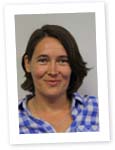Centre Specific Report - Bringing patient population trends into focus
 The Centre Specific Reports are new to HIV treatment centre teams. Mariska Hillebregt, data monitor at SHM, has been involved in developing this entirely new product since the end of 2009. She met with the editors of SHM’s Newsletter to explain the in’s and out’s of the report.
The Centre Specific Reports are new to HIV treatment centre teams. Mariska Hillebregt, data monitor at SHM, has been involved in developing this entirely new product since the end of 2009. She met with the editors of SHM’s Newsletter to explain the in’s and out’s of the report.
What is the Centre Specific Report and why was this product developed?
To date, the data collected and analysed by SHM was only presented as total data for the entire group of HIV treatment centres. There has, however, been the desire for quite some time for HIV treatment centres to have access to collected data for their own patient group. On a patient level, each HIV treatment centre has access to individual data via the Patient Reports. As this data is raw data it needs to be processed for presentation at a group level, a service that SHM was pleased to offer in the form of the Centre Specific Report. The report offers each HIV treatment centre a complete overview of developments and trends within their own patient population. It should be viewed as a broad outline of basic information. We have therefore chosen to present the information as an outline with little detail available. Nineteen topics are presented including data on registration, demographic data, transmission and co-infections. Reasons for discontinuation of antiretroviral medication, CDC events and adverse events are also covered.
Who has this product been developed for?
The Centre Specific Report has been designed for HIV treatment centre teams and researchers to provide a complete overview of the developments and trends within their own patient population.
How long did it take to create these new reports? How did this process develop?
We started looking into creating these reports at the end of 2009. We began by looking at which topics leant themselves to showing trends in graph form. We initially started with a range of different charts made for each topic. In 2011 we met with a panel of clinicians and selected the most suitable topics and reviewed the different types of charts available. Eventually, we had 19 topics remaining and these were to be presented as stacked column charts outlining percentages, which could then be compared against the SHM total. In 2012 the website was built and we invited the clinicians’ panel to test the website. During the testing phase we reviewed each graph and tested the registration procedure.
How can users access and use the report? What is the added value?
The Centre Specific Report is accessible via the Medical Professionals section of SHM’s website. Once a year, the graphs will be updated with new data. Following registration, users can view each graph and make comparisons with the results in their hospital versus the total collated by SHM. The graphs can be easily converted to different formats, including JPEG and PDF, for use in presentations and reports. This information can be used by the researchers and treatment teams within an HIV treatment centre to give further insight into their patient group. Ultimately, the goal of the provision of this type of data is to enable optimal treatment and care of HIV-infected individuals.
